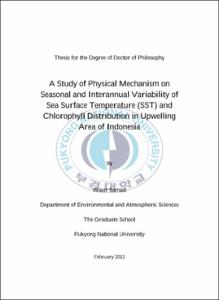A Study of Physical Mechanism on Seasonal and Interannual Variability of Sea Surface Temperature (SST) and Chlorophyll Distribution in Upwelling Area of Indonesia
- Abstract
- Aqua-MODIS의 위성 자료와 기후변동지수(Nino 3.4와 인도양 Dipole(IOD))을 이용해서 2002년부터 2012년 중반까지 인도네시아 수문에서 SST와 엽록소 변동성을 분석했다. 해수면에서 높거나 낮은 엽록소 및 SST 농도는 이것의 mechanism과 generating-force에 기반을 둔다. Java와 Sumatra해안을 따라 SST와 엽록소 아노말리 사이에 음의 상관을 발견하였다. 더 높은 엽록소 농도는 남동풍에 의해 야기된 JJA(6월~8월)기간에서 SON(9월~ 11월)까지의 평년보다 낮은 SST에 의해 특징지어진다. 경년 및 계절 변동성의composite 분석을 통해SST와 엽록소 간의 연관성을 찾을 수 있다. 엽록소 아노말리는 2006년에 IOD를 동반한 서남아시아 몬순기간에 상당히 증가하였으며 이때 엽록소는 1 mg m-3 이상이었고 가능한 다른 데이터와 비교했을 때 SST는 평년보다 낮은 값을 기록했다. 그러나, ENSO가 발생한 해에도 같은 현상을 발견할 수 있었다.
분석을 통해 남동풍뿐만 아니라 인도양 Dipole 현상에 의해 계절 변동성이 영향을 받는 것을 추가적으로 확인할 수 있었으며, 본 연구는 계절적 시간 규모의 물리 메커니즘에 대한 표면 엽록소 존재의 반응을 밝힐 수 있었다.
핵심어: 동남아시아 몬순, 해수면온도, 엽록소, ENSO, IOD, 계절 및 경년 변동
The variations of SST and chlorophyll in Indonesian waters during 2002 – mid 2012 have been analyzed, using satellite data on Aqua-MODIS and indices of climate variability (Nino 3.4 and Indian Ocean Dipole (IOD)). High-low of the SST and chlorophyll concentration on the sea surface varies based on their mechanism and generating-force. An inverse relationship has found between SST and chlorophyll anomalies along the coasts of Java and Sumatra. Higher chlorophyll concentration is characterized by the lower than normal SST during June-July-August (JJA) to September-October-November (SON) as triggered by southeasterly wind blows. Based on the composite analysis of seasonal and interannual variability can be formulated the relationship between SST and chlorophyll. Chlorophyll anomalies significantly increased during southeast monsoon accompanied by IOD event during 2006 which is peak period, reaching > 1 mg m-3 when the SST dropped below normal as compared with other available data. However, the same analysis of this phenomenon is also found during year’s period of ENSO event.
The analysis further shows that the seasonal variability is influenced not only by southeasterly wind but also by the Indian Ocean Dipole event. This study highlights the existence of surface chlorophyll responses to physical mechanism on seasonal time scales.
Keywords: Southeast monsoon, SST, chlorophyll, ENSO, IOD, seasonal and interannual variation.
- Issued Date
- 2013
- Awarded Date
- 2013. 2
- Type
- Dissertation
- Publisher
- 부경대학교
- Affiliation
- 부경대학교 대학원
- Department
- 대학원 지구환경시스템과학부환경대기과학전공
- Advisor
- Prof. Jai-Ho Oh
- Table Of Contents
- Summary
Table of Contents
List of Figures
List of Tables
Abstract
1.Introduction 1
1.1 Background 1
1.2 Motivation of the present work 3
1.3 Objectives of Study 4
2. Literature Review 5
2.1 Global Circulation 5
2.1.1 Brief understanding of the heat transfer 5
2.1.2 A mechanism view of the circulation 9
2.2 Radiative Forcing and Temperature 11
2.2.1 Incoming radiation 11
2.2.1.1 Annual mean 11
2.2.1.2 Seasonal mean 12
2.2.2 Outgoing radiation 13
2.2.3 Heat fluxes equation 14
2.3 Physical background of Energy transfer mechanism 18
2.3.1 Heat budget of the upper ocean mixed layer 21
2.3.2 Atmospheric forcing 22
2.3.2.1 Sea Level Pressure 22
2.3.2.1 Wind 23
2.3.3 Various of parameters in the oceanic process 26
2.3.3.1 Sea surface temperature datasets 26
2.3.3.2 Chlorophyll 31
2.4 Satellite Data - MODIS on Aqua 32
2.4.1 Remote sensing 32
2.4.2 Brief description of satellite data-MODIS 33
2.5 Climate Variability 36
2.5.1 El Nino – Southern Oscillation (ENSO) 36
2.5.1.1 Multivariate ENSO Index 37
2.5.1.2 Southern Oscillation Index (SOI) 38
2.5.1.3 Oceanic NINO Index (ONI) 41
2.5.2 Indian Ocean Dipole (IOD) 42
2.5.2.1 Dipole Mode Index (DMI) 42
2.5.2.2 ENSO – IOD in coupling ocean-atmosphere 44
2.5.3 ENSO periods 44
2.5.3.1 The years of ENSO 46
2.5.3.2 ENSO influence to the climate variability over Indonesia 48
2.6 SST – Sea Surface Chlorophyll a considering mechanism 49
2.6.1 Effect of Climate variability on SST and Chl 49
2.6.2 Anomaly of SST and chlorophyll 50
2.7 Upwelling 51
2.7.1 Characteristic features of upwelling 51
2.7.2 Physical mechanism of upwelling 52
2.7.3 Potential Fishing grounds in Indonesia 55
3. Data and Methods 57
3.1 Available Data 57
3.1.1 Wind Surface 58
3.1.2 Sea Surface Temperature 58
3.1.3 Sea Surface Chlorophyll 59
3.1.4 Sea Level Pressure 59
3.2 Methods 60
3.2.1 SST and chlorophyll distribution 60
3.2.2 Surface Wind field over study domain 62
3.2.3 Sea Level Pressure 63
3.2.4 The Years of ENSO and IOD 64
3.3 Statistical Analyses 65
3.3.1 Calculation of Annual and Seasonal Scale 65
3.3.2 Calculation of monthly and annual anomaly 66
3.3.2.1 Seasonal Scale 66
3.3.2.2 Annual Scale 67
4. Results and Discussion 69
4.1 Seasonal variability during El Nino and IOD 70
4.1.1 Surface wind pattern over study domain 70
4.1.2 Spatio-temporal variability of SST 74
4.1.3 Spatio-temporal variability of chlorophyll 80
4.1.4 Sea Level Pressure (SLP) 85
4.2 Seasonal variability during La Nina and IOD 87
4.2.1 Surface wind patterns over study domain 87
4.2.2 Spatio-temporal variability of SST 91
4.2.3 Spatio-temporal variability of chlorophyll 95
4.2.4 Sea Level Pressure 99
4.3 Interannual variability between SST and Chlorophyll 101
4.3.1 Spatio-temporal variability of SST anomalies 101
4.3.2 Spatio-temporal variability of chlorophyll anomalies 103
4.4 Inverse relationship between SST and Chlorophyll 105
4.4.1 SST and Chlorophyll 105
4.4.2 Upwelling area 107
4.4.3 The estimation of Primary Production 110
4.4.4 Fish distribution at southern Java and Sumatra 112
5. Conclusions 114
References 117
Acknowledgments 132
ABREVIATIONS 134
APPENDIX 136
- Degree
- Doctor
- Appears in Collections:
- 대학원 > 지구환경시스템과학부-환경대기과학전공
- Files in This Item:
-
-
Download
 A Study of Physical Mechanism on Seasonal and Interannual Variability of Sea Surface Temperature (SS.pdf
기타 데이터 / 10.88 MB / Adobe PDF
A Study of Physical Mechanism on Seasonal and Interannual Variability of Sea Surface Temperature (SS.pdf
기타 데이터 / 10.88 MB / Adobe PDF
-
Items in Repository are protected by copyright, with all rights reserved, unless otherwise indicated.